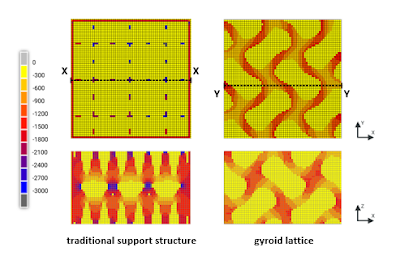Customer Spotlight: Centre for Additive Manufacturing, University of Nottingham
Simulating Selective Laser Melting (SLM)
SLM is an Additive Manufacturing (AM) technology for producing end-use components by melting metallic powders using high density energy flux created by a moving laser source.
The team at Nottingham had clear motivation for researching what happens during the manufacturing process as the large thermal gradients result in transient and permanent residual stresses that may cause:
- Failure and/or distortion during manufacture
- Distortion upon removal from the build platform
- Overall reduction in part performance (e.g. reduced fatigue resistance)
Post Build Cracking
By simulating the process, it will identify the heat transfer during manufacture as well as the the distribution and magnitude of residual stress.
Modelling SLM however is very challenging and computationally
intensive due to the transient and non-linear nature of the process both across
time and space. This is because the model requires to capture the exposure of the fine laser (70 micron size) which raster across each layer (40 micron
thickness) across a relatively large part. Due to the extremely high
temperature gradients created by the exposure of the laser, an extremely fine
mesh resolution is required.
The capabilities offered in Marc in
particular adaptive meshing, time-stepping and extensibility, and the parallel
solver performance were vital for studying the process under different
scenarios.
Feedback received from the researchers detailed that Marc features around material models and the documentation of the user subroutines were powerful tools to model these specific manufacturing problems. The
post-processing capability offered in Python scripting language (PyPost) was also important to
analyse the results with higher efficiency.
To summarise: Marc was chosen as the software to investigate this problem for a variety of reasons:
- Competency dealing with highly non-linear manufacturing problems
- Scalability (DDM, parallel performance)
- Well documented and extensive list of User Defined Subroutines
- Fairly user friendly pre/post processor via Mentat
- Excellent technical support from local MSC UK office
- Weakly coupled transient thermo-mechanical analysis
- State variable model to track material properties for (powder, liquid ,solid)
- Thermal dependent thermal and mechanical properties + Plasticity Modelling
- Layer and element activation
- Adaptive time-stepping
- Local adaptive meshing
- Direct laser scan path and parameter modelling
- Extensive use of Fortran subroutines and additional C++ coupling for extra functionality
Temperature Distribution
State Variable Tracking
Powder = -1, Liquid = 0, Solid = 1
Von Mises Stress Distribution
But wait there's more!
They further investigated the effects of adding the next powder layer ontop for a 'real' 3D analysis:
Temperature Distribution
Von Mises Stress Distribution
Once the process setup was defined, more detailed analyses were defined for higher resolution scanning strategies. The figure below shows the highly transient behaviour of the process with the development of residual stress from the localised heat input.
Thermo-mechanical behaviour for 3x3mm area for Ti-6Al-4V
The transient animation showing the local adaptive remeshing that was required to fully capture the highly localised effects for a 5x5mm patch:
Temperature
Von Mises Stress
The investigation further progressed into the effect of lattice structures on the generation of residual stress.
Comparison of Steady State Effective Heat Transfer
Von Mises Stresss
Thermal History and State Variable Tracking
Lastly to end with the ultimate combination of all the analysis development from the above processes:
For more details, please take a closer look at the research paper here:
For more details contact:
Luke Parry
Centre for Additive Manufacturing
University of Nottingham
More to come!













